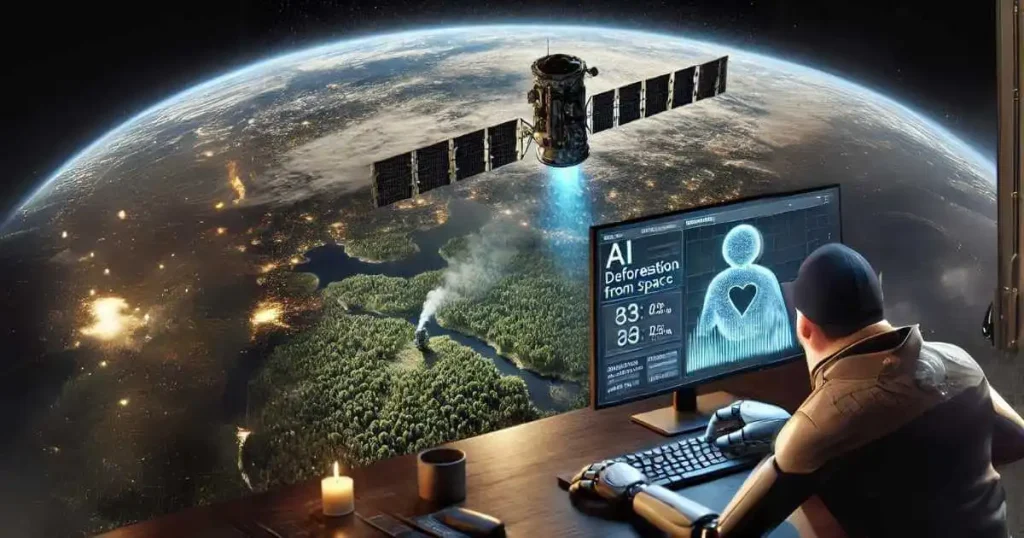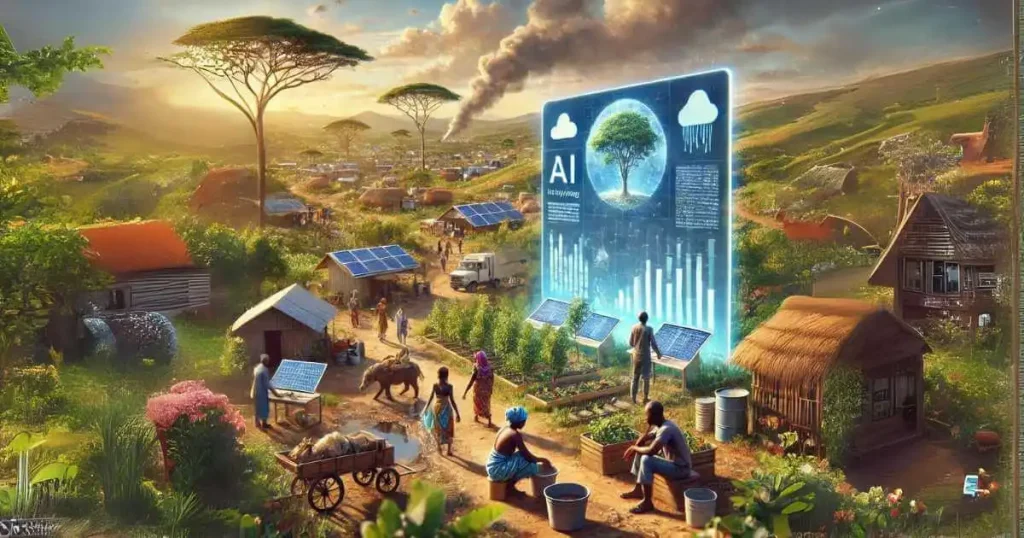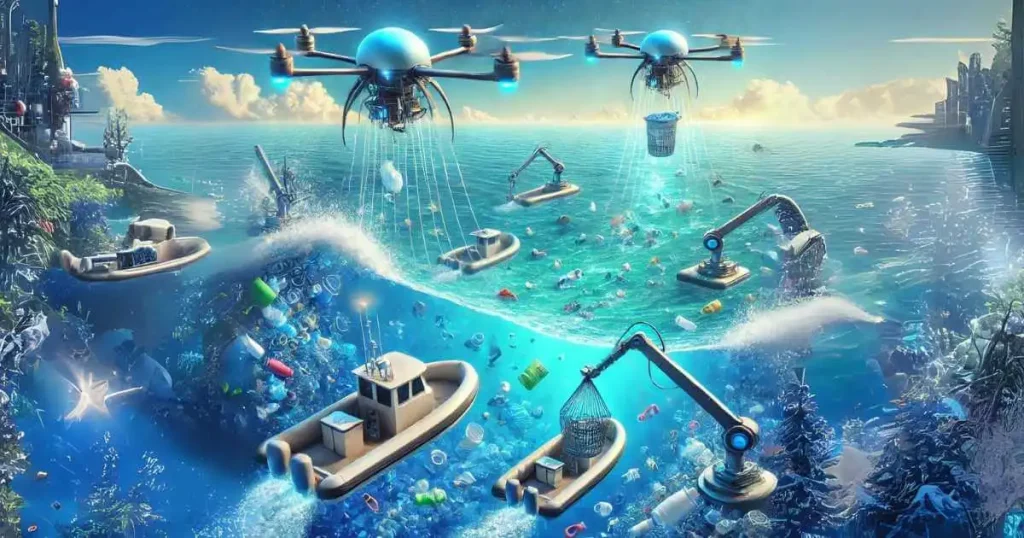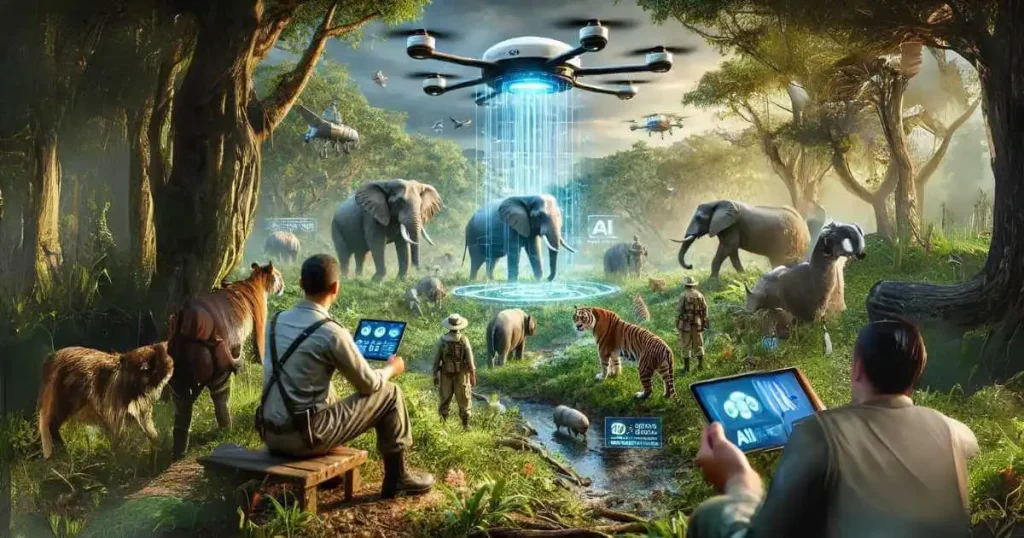Mother Nature vs. Machine: Can AI Become Earth’s Superhero?
For decades, science fiction has painted a picture of AI as a potential threat to humanity. But what if the future of our planet hinges on a powerful alliance between humans and artificial intelligence?
Environmental AI Projects are emerging as a game-changer in the fight against climate change, pollution, and biodiversity loss.
Imagine AI systems that predict weather disasters with unprecedented accuracy, robots that clean up plastic pollution in our oceans, or algorithms that identify and protect endangered species. These are not distant dreams; they’re real-world projects making a tangible difference today.
In this article, we’ll be your guide through this fascinating world of Environmental AI Projects. We’ll unveil 9 groundbreaking initiatives that are leveraging the power of AI to tackle some of our planet’s most pressing environmental challenges.
Get ready to discover innovative solutions, inspiring success stories, and a glimpse into a future where AI becomes Earth’s most powerful ally. So, buckle up and join us on a journey brimming with hope and the potential of technology to heal our planet.

As you explore the intersection of technology and sustainability, you may be wondering how artificial intelligence (AI) can be harnessed to address the pressing environmental issues of our time. From tracking melting icebergs to mapping deforestation, AI is being leveraged in innovative ways to combat climate change.
In this article, we’ll investigate nine inspiring environmental AI projects that are transforming industries and mitigating the impact of climate change. Get ready to discover how AI is being used to predict weather patterns, improve agriculture, and even clean up the ocean.
1. Environmental Monitoring
For effective environmental monitoring, AI plays a crucial role in tracking changes in our planet’s ecosystem. From monitoring icebergs to detecting deforestation, AI-powered systems help scientists and researchers understand the impact of climate change on our environment.
Icebergs are melting – AI knows where and how fast
Rapidly, AI systems are being trained to measure changes in icebergs at an unprecedented rate, 10,000 times faster than human capabilities.

This enables scientists to understand the amount of meltwater icebergs released into the ocean, a process accelerated by climate change.
Mapping deforestation with AI
The power of AI, combined with satellite images and ecology expertise, is being harnessed to map the devastating impact of deforestation on the climate crisis. Space Intelligence, a company based in Edinburgh, Scotland, has already mapped over 1 million hectares of land from space using satellite data.

It is remarkable to note that this technology remotely measures metrics such as deforestation rates and the amount of carbon stored in a forest. This data is invaluable in understanding the extent of deforestation and its contribution to climate change.
2. Climate Risk Management
You are likely aware of the devastating impact of climate change on communities around the world. Rising temperatures, more frequent natural disasters, and unpredictable weather patterns are just a few of the many challenges that come with climate change. Fortunately, AI is being used to help manage these risks and protect vulnerable communities.
AI is helping communities facing climate risks in Africa
Facing the harsh realities of climate change, communities in Africa are turning to AI for support. In a United Nations project, AI technology is being used to predict weather patterns, enabling communities and authorities to better plan for climate change and mitigate its impact.

This includes improving access to clean energy, implementing proper waste management systems, and encouraging reforestation.
AI helps predict climate disasters
An innovative company in São Paulo, Brazil, is using AI to predict where and when climate disasters will occur, and what type of climate disasters they will be. This crucial information helps businesses and governments prepare for the growing challenges that come with climate change.

To take this a step further, AI can analyze a wide range of factors, including air quality, to inform decisions on whether to delay or suspend events. This not only saves lives but also helps minimize the economic impact of climate-related disasters. By providing accurate predictions, AI is becoming a vital tool in the fight against climate change.
3. Waste Reduction and Recycling
Little did we know that waste management plays a significant role in the fight against climate change. According to the United States Environmental Protection Agency, waste is responsible for 16% of global greenhouse gas (GHG) emissions.
Fortunately, AI is stepping in to help reduce waste and increase recycling rates. Here are some innovative projects that showcase the potential of AI in waste reduction and recycling:
Using AI to recycle more waste
Daily, waste processing and recycling facilities struggle to identify and recover valuable materials from waste streams.

Greyparrot, a software startup based in London, has developed an AI system that analyzes waste processing and recycling facilities to help them recover and recycle more waste material.
AI is cleaning up the ocean
One of the most pressing environmental issues today is plastic pollution in our oceans. In the Netherlands, an environmental organization called The Ocean Cleanup is using AI and other technologies to help clear plastic pollution from the ocean.

Understanding the severity of ocean pollution, The Ocean Cleanup is leveraging AI to detect objects and create detailed maps of ocean litter in remote locations.
This enables the organization to gather and remove ocean waste more efficiently than traditional cleanup methods. By tackling plastic pollution, we can reduce greenhouse gas emissions and protect marine life.
4. Decarbonization and Industry
Keep in mind that industries such as metal and mining, oil, and gas are significant contributors to greenhouse gas emissions, accounting for around 30% of global emissions. However, AI can play a crucial role in helping these industries decarbonize their operations.
How AI can help industry decarbonize
The use of AI can significantly reduce emissions in industries by tracking, tracing, and reducing emissions by 20-30%.

For instance, Eugenie.ai, a California-based company, has developed an emissions-tracking platform that combines satellite imagery with data from machines and processes, enabling companies to monitor and decrease their emissions.
Reforesting hills in Brazil using drones
Reforesting efforts in Brazil are getting a boost from AI-powered drones, which are dispersing seeds in hard-to-reach areas around Rio de Janeiro.
This innovative approach is 100 times faster than traditional reforestation methods.

Understanding the scale of this initiative, a single drone can disperse 180 seed capsules per minute, making it a game-changer for reforestation efforts. The partnership between Rio’s city hall and start-up Morfo aims to grow seeds in areas that were previously inaccessible, promoting a greener and more sustainable future.
5. AI-Powered Climate Tools
Many researchers and organizations are leveraging the power of artificial intelligence to combat climate change. AI-powered climate tools are being developed to predict weather patterns, track icebergs, identify pollution, and improve agriculture, among other applications.
A wish list of AI climate tools
For instance, Google DeepMind is working on building a complete wish list of datasets that would advance global AI solutions for climate change. This collaboration with Climate Change AI, a non-profit organization, aims to identify the most critical areas where AI can make a significant impact in fighting climate change.
The potential of AI in the future
AI-powered climate tools can potentially revolutionize our approach to mitigating climate change. By processing vast amounts of data and providing insights that humans might miss, AI can help scientists, policymakers, and businesses make informed decisions to reduce greenhouse gas emissions and adapt to the changing climate.
Climate change is one of the most pressing issues of our time, and AI has the potential to play a crucial role in addressing it. With the ability to analyze large datasets, identify patterns, and make predictions, AI can help us better understand the impacts of climate change and develop effective strategies to mitigate its effects. As the technology continues to evolve, we can expect to see even more innovative applications of AI in the fight against climate change.
Ready to harness the power of AI for a better tomorrow? Explore the exciting possibilities and navigate potential challenges with our in-depth guide on AI innovation: The Future of AI Innovation: Trends & Challenges
6. AI Applications in Environmental Conservation
Despite the numerous challenges facing our planet, AI is emerging as a powerful tool in the fight against environmental degradation. From protecting endangered species to optimizing conservation efforts, AI is being leveraged in innovative ways to preserve our natural world.
Protecting endangered species with AI
The rapid decline of biodiversity is a pressing concern, with many species teetering on the brink of extinction.

AI is being used to monitor and track endangered species, enabling conservationists to respond quickly to threats and develop targeted protection strategies.
AI-assisted conservation efforts
Efforts to conserve our natural resources are being supercharged by AI, which can analyze vast amounts of data to identify areas of high conservation value and optimize resource allocation.
This is particularly important in the face of climate change, where every minute counts in the race to protect vulnerable ecosystems. By leveraging AI, conservationists can streamline their efforts, reduce costs, and achieve greater impact.
7. Climate Change Mitigation Strategies
After recognizing the severity of climate change, it’s vital to explore effective strategies for mitigating its impacts. Artificial intelligence (AI) can play a vital role in this endeavor, and you’ll discover how AI-driven approaches can help combat climate change.
AI-driven climate change mitigation strategies
Any effective climate change mitigation strategy relies on accurate data analysis and informed decision-making. AI can process vast amounts of data quickly and efficiently, enabling scientists and policymakers to identify patterns, predict trends, and make data-driven decisions to combat climate change.
Implementing AI-based climate solutions
With the power of AI, you can implement innovative climate solutions that drive meaningful change. From predicting weather patterns to identifying areas of deforestation, AI can help you develop targeted strategies to mitigate the effects of climate change.
Mitigation efforts require a multifaceted approach, and AI can facilitate this by analyzing complex systems, identifying areas of improvement, and optimizing processes. For instance, AI can help optimize energy consumption, reduce waste, and promote sustainable agriculture practices. By leveraging AI in climate change mitigation, you can accelerate progress toward a more sustainable future.
8. Collaboration and Partnerships
All environmental AI projects require collaboration and partnerships to achieve their goals. As you explore the potential of AI in addressing environmental issues, it becomes clear that no single entity can tackle these complex problems alone.
Building partnerships for environmental AI projects
On the path to developing effective environmental AI projects, building partnerships is crucial. This involves bringing together experts from various fields, including AI researchers, environmental scientists, policymakers, and industry leaders. By combining their knowledge and expertise, these partnerships can accelerate the development of innovative solutions to environmental challenges.
Collaborative efforts for a sustainable future
Environmental AI projects rely on collaborative efforts to drive meaningful change. By working together, stakeholders can share resources, expertise, and risks, ultimately leading to more effective and sustainable solutions.
For instance, initiatives like the IKI Project in Africa, which uses AI to help communities vulnerable to climate change, demonstrate the power of collaboration. By bringing together the United Nations, local authorities, and AI experts, this project can provide critical support to communities facing climate risks. Similarly, partnerships between companies like Google DeepMind and non-profit organizations like Climate Change AI are driving innovation in AI applications for climate change mitigation.
9. Policy and Regulation
Once again, as we explore environmental AI projects, it becomes evident that policy and regulation play a crucial role in shaping the trajectory of these initiatives.
The role of policy in environmental AI projects
For instance, effective policy frameworks can provide the necessary incentives and guidelines for businesses and governments to invest in AI-driven environmental projects, ensuring their successful implementation and scalability.
Regulatory frameworks for AI-driven environmental initiatives
Regulation is imperative to ensure that AI systems are designed and deployed in a responsible and sustainable manner, minimizing potential risks and negative impacts on the environment.
The development of regulatory frameworks that address the unique challenges and opportunities presented by AI-driven environmental initiatives is critical. This includes establishing standards for data collection, use, and sharing, as well as ensuring transparency and accountability in AI decision-making processes. By doing so, you can trust that AI systems are working towards the betterment of the environment, rather than exacerbating existing problems.
The Agenda
Now that we’ve explored the significance of environmental AI projects, it’s imperative to outline the agenda for prioritizing and implementing these initiatives.
Prioritizing environmental AI projects
The pressing need to address climate change demands that we focus on environmental AI projects that can deliver tangible results. You must identify areas where AI can make the most significant impact, such as predicting and mitigating the effects of natural disasters, optimizing resource usage, and promoting sustainable practices.
A call to action for environmental AI initiatives
Any effective response to climate change requires a collective effort, and environmental AI projects are no exception. You have a crucial role to play in driving these initiatives forward, whether as an individual, organization, or government entity.
Action is needed to accelerate the development and deployment of environmental AI projects. This involves investing in research and development, fostering collaboration between stakeholders, and creating policies that support the adoption of AI-driven solutions. By working together, you can help unlock the full potential of environmental AI projects and create a more sustainable future for all.
Challenges and Limitations
Unlike other technological advancements, environmental AI projects face unique challenges and limitations that can hinder their effectiveness and scalability.
Addressing challenges in environmental AI projects
For instance, the quality and availability of data can significantly impact the accuracy of AI models, making it important to develop strategies for data collection, processing, and integration.
Overcoming limitations in AI-driven environmental initiatives
The complexity of environmental systems and the need for interdisciplinary approaches can lead to limitations in AI-driven initiatives, requiring careful consideration of the social, economic, and ecological contexts in which they operate.
With the increasing reliance on AI in environmental projects, it is crucial to acknowledge and address these limitations to ensure that AI solutions are effective, equitable, and sustainable. This involves engaging with diverse stakeholders, incorporating traditional knowledge, and fostering transparency and accountability in AI decision-making processes.
Future Directions
Your exploration of environmental AI projects has shown you the incredible potential of artificial intelligence in tackling climate change. As we move forward, it’s crucial to consider the emerging trends and future directions of environmental AI projects.
Emerging trends in environmental AI projects
On the horizon, we’re seeing a growing focus on integrating AI with other technologies, such as IoT and blockchain, to create more comprehensive and effective environmental solutions. This convergence of technologies will enable more accurate data collection, better decision-making, and increased transparency in environmental conservation efforts.
The future of AI in environmental conservation
Environmental AI projects are poised to revolutionize the way we approach conservation. With AI’s ability to process vast amounts of data and identify patterns, it will become increasingly important in predicting and preventing environmental disasters, optimizing resource allocation, and developing sustainable practices.
Another critical aspect of AI in environmental conservation is its potential to engage and educate communities about environmental issues. By leveraging AI-powered tools, such as virtual reality and gamification, we can create immersive experiences that raise awareness and inspire action. This will be crucial in building a global movement toward environmental sustainability.
Best Practices
Not every environmental AI project is successful, and there are many lessons to be learned from those that have failed. However, by following best practices, you can increase the chances of your project’s success.
Effective implementation of environmental AI projects
A vital aspect of effective implementation is to clearly define the problem you are trying to solve and identify the specific environmental issue your project aims to address. This will help you to develop a targeted approach and ensure that your project remains focused on its goals.
Lessons learned from successful environmental AI initiatives
From the experiences of successful environmental AI initiatives, we can distill valuable insights that can inform and improve your own project.
Learned from the examples mentioned earlier, such as the use of AI in tracking icebergs, mapping deforestation, and predicting climate disasters, is the importance of collaboration and interdisciplinary approaches. By combining AI expertise with domain-specific knowledge and stakeholder engagement, you can develop more effective and sustainable solutions that address the complexities of environmental issues.
Final Words
To wrap up, as you’ve seen, environmental AI projects are revolutionizing the way we tackle climate change. From predicting iceberg melting to reforesting hills in Brazil, these innovative projects are harnessing the power of artificial intelligence to make a tangible impact on our planet’s future. As you continue on your journey to learn more about environmental AI projects, remember that every small step counts, and together, we can create a more sustainable tomorrow.
